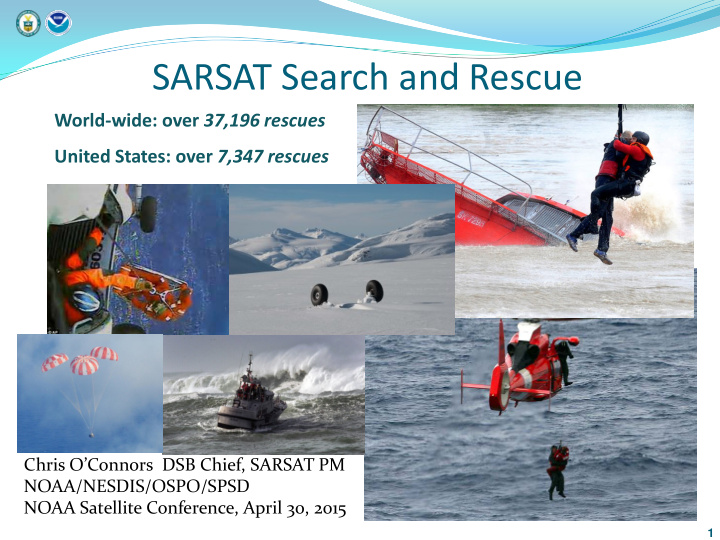



SARSAT Search and Rescue World-wide: over 37,196 rescues United States: over 7,347 rescues Chris O’Connors DSB Chief, SARSAT PM NOAA/NESDIS/OSPO/SPSD NOAA Satellite Conference, April 30, 2015 1
Background / History 1967 16-year old girl dies after two months waiting for rescue 1970 Congress mandates carriage of 121.5 ELT on general aviation aircraft 1972 Congressmen Boggs and Begich lost in Alaska plane crash 1975 Apollo-Soyuz Test Project 1982 COSPAS-SARSAT first rescue 1985 COSPAS-SARSAT Declared Operational 1998 Geostationary space segment becomes operational 1998 Cospas-Sarsat announces termination of 121/243 MHz service starting in 2009 2009 Termination of 121.5 and 243 MHz processing by space segment
Cospas-Sarsat System Overview Cospas-Sarsat (C-S) Program uses dedicated Search and Rescue (SAR) payloads onboard satellites to relay beacons signals to ground stations C-S system consists of three segments: User Segment – the emergency beacon transmitters Marine: EPIRB (Emergency Position Indicating Radio Beacon) Aviation: ELT (Emergency Locating Transmitter) Land: PLB (Personal Locating Beacon) Ground Segment – Local User Terminals (LUTs) Space Segment LEOSAR: Low-Earth Orbit - Provides for beacon location using Doppler processing; uses Store & Forward instrument to provide global coverage GEOSAR: Geosynchronous Orbit Performs instantaneous alerting function; no locating capability unless beacon is equipped with GNSS receiver. MEOSAR *: Mid-Earth Orbit SAR – Under development 3
C-S Participants • 43 countries and organizations • Cooperates with International Maritime Organization (IMO), International Civil Aviation Organization (ICAO) and the International Telecommunications Union (ITU) 4
EPIRB ELT PLB 5
SARSAT Space Segment MEOSAR schedule FOC overlap IOC 10 11 12 13 14 15 16 17 18 19 20 21 22 23 24 25 26 27 28 29 30 31 32 33 34 35 36 N15/S-7 COSPAS-13 N18/S-10 COSPAS-14 MetOp-A/S-11 LEOSAR MetOp-B/S-13 N19/S-12 SIDAR GOES-13 GOES-15 GEOSAR GOES-14 (Spare) GOES-R GOES-S GOES-T GOES-U SAR/GLONASS MEOSAR SAR/Galileo GPS II F DASS (S-Band) GPS III SV1-8 (S-Band) GPS III SAR/GPS SV-11+ GPS IV (purple=USA; green=EUMETSAT/EU; gold=Russia) continued operation 6
Current U.S. Local User Terminals (LUTs) Alaska NOAA FCDA 2 LEOLUTs Maryland* NOAA NSOF California Vandenburg AFB Guam Andersen AFB 2 LEOLUTs *Maryland has 3 GEOLUTs & 1 LEOLUT US Mission Control Center Hawaii Miami USCG COMMSTA Honolulu USCG COMMSTA Miami 2 LEOLUTs 2 LEOLUTs 6 antenna MEOLUT 6 antenna MEOLUT 7
SPACE SEGMENT COMPARISON Current SARSAT systems requires 4 Low Earth Orbiting (LEO) satellites Beacon detection • within 10 min with GEOSAR • A few minutes to 2 hours on • LEOSAR Location determined within 1-2 • hours with 5 km accuracy Search and Rescue Global Position System (SAR/GPS) Medium Earth SAR Aircraft Orbiting Search and Rescues (MEOSAR) vastly improves capability - Instantaneous Notification & • Distress Alerting Satellite System (DASS) Proof- Location of-Concept includes repeater on GPS IIR, IIR-M, Global Coverage • and IIF SVs 100% Availability • • Leveraging existing capability on GPS No Terrain Blockage • Improved Accuracy • • Provides demonstration capability 1 st Gen 1KM • 17 satellites in orbit with SAR capability 2 nd Gen 100-500m 8
MEOSAR Next generation of satellite-aided SAR Based on the use of SAR Repeaters carried on board Global Navigation Satellite System (GNSS) satellites Global Navigation constellations consist of 24 (or more) satellites Mid Earth Orbit (GPS, Galileo, GLONASS) Provides Near instantaneous beacon detection and location, globally, at all times Advanced location process using time and frequency measurements of beacon signal to triangulate its location Mitigates terrain blockage due to multiple look angles from multiple moving satellites Robust space segment, well maintained and highly redundant Simple space segment repeater allows for development of higher performance beacon signal 9
MEOSAR Concept of Operations 10
Galileo RLS Protocol Message sent by the distress beacon (specific RLS protocol on the 406 MHz uplink signal) to the RLS Provider (RLSP) to indicate it has a Return Link capability 11
Second Generation 406 Beacons Project Goals • Capitalize on MEOSAR space segment and improve system performance to meet or exceed C/S requirements, including: Detection probability, location accuracy and system capacity - - Reduce cost and complexity of beacons - Collaborate with manufacturers to obtain the most competitive end product Progress to date • Technology selected - Spread Spectrum (similar to cell phones) Improved detectability • • Enhanced location performance • Expanded message content • Additional data fields • Two-way messaging capability (under discussion) 12
SGB Current Results • NASA prototype beacon SGB locations over 2-day duration signal transmitted over 48hr period (1 burst every 50 sec) through DASS; • Locations collected at NASA MEO ground station Location accuracy meets C/S SGB requirements for location accuracy: shows that at least 95% of the results of the 30 minute average are within the 100m (red) circle order of magnitude improvement from first generation beacons 13
Support Search and Rescue Get Lost! http://www.sarsat.noaa.gov http://www.cospas-sarsat.int 14
Recommend
More recommend